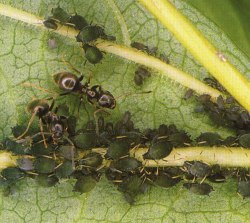Sternorrhyncha (True bugs - Order: Hemiptera)
Back to the main True bugs page.

Ants 'farm' aphids and protect them from predators such a ladybirds. In return the ants collect sugary honeydew from the aphids.
The psyllids (superfamily Psylloidea) are small or very small insects that look like mini cicadas. They are also known as jumping plant lice, and many of them deform leaves or cause plants to form galls.
There are more than 4,000 species in the superfamily Aphidoidea and these are the insects known as aphids, plant lice, greenfly and blackfly. They have the ability to reproduce at a fast rate and as they feed on the sap of young shoots and leaves this makes them serious pests. Most aphids are 2-3mm long and they are mainly green or brown in colour. Many species have wingless forms and those with wings usually hold them tentlike above the body.
Their lifecycle through the year starts with an overwintering phase as eggs, somewhere on the host plant. In the spring, wingless females emerge which can reproduce by parthenogenesis - i.e. without sexual reproduction. They give birth to numerous live young nymphs every day. These nymphs are slightly different from the mother, and some of them will have wings.
Throughout the summer there are a number of generations of these parthenogenetic females, the winged forms alternating with wingless ones. The winged form is responsible for spreading the species from plant to plant. As autumn approaches, the females start to give birth to males as well as females, and after mating the females lay the eggs which overwinter, to hatch as females the following spring.
Among the other members of the Sternorrhyncha is a group of atypical insects in the superfamily Coccoidea, known as scale insects and mealybugs. There are around 170 species in Britain. The females of many species in this group are wingless and even legless: they remain motionless, attached to their foodplant by their beak. They are covered by a hard waxy scale.
The males look more like insects; they are usually winged, with the hindwings reduced to halteres, as in the Diptera. However, the males are rarely seen, so what we know about these creatures is based mostly on our knowledge of the females.
Like the aphids, the scale insects produce many young in a generation, and parthenogenesis and viviparity (giving birth to live nymphs rather than laying eggs) is commonplace. The newborn nymphs are mobile, but lose their legs after their first moult.
Scale insects can be serious pests, capable of killing whole trees. They are easily transported from place to place on plant material and they have spread around the world. An example of biological control of these pests is the Fluted Scale (Icerya purchasi) which was introduced to America from Australia. It was controlled by releasing large numbers of the predatory ladybird beetle Rodolia cardinalis.
Essential reading from the Amateur Entomologists' Society
Back to the True bugs, or view the other suborders: Auchenorrhyncha, Coleorrhyncha or Heteroptera.
A to Z of insects
- Alderflies
- Ants
- Antlions
- Archaeognatha
- Barklice
- Bees
- Beetles
- Biting lice
- Booklice
- Butterflies
- Bugs
- Caddisflies
- Cockroaches
- Crickets
- Damselflies
- Dobsonflies
- Dragonflies
- Earwigs
- Fleas
- Flies
- Grasshoppers
- Lacewings
- Leaf insects
- Lice
- Mantids
- Mayflies
- Moths
- Praying Mantids
- Scorpionflies
- Snakeflies
- Stick insects
- Stoneflies
- Strepsipterans
- Sucking lice
- Termites
- Three-pronged bristletails
- Thrips
- True Bugs
- Wasps
- Web-spinners
- Zorapterans
- Non-insect hexapods
- Proturans
- Springtails
- Two-pronged bristletails
![Amateur Entomologists' Society home page [Logo]](/images/aes-logo-wplant.gif)